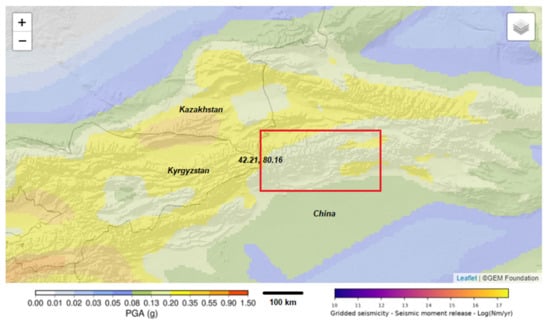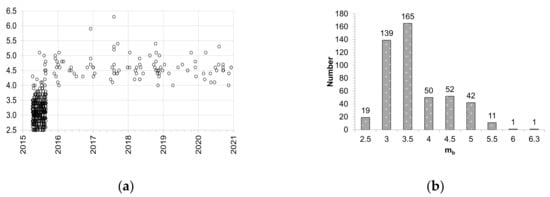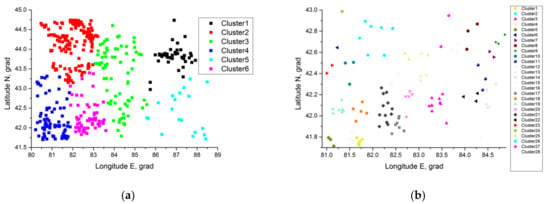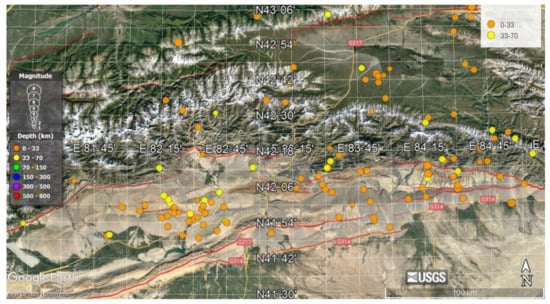Abstract
This research is the first stage of seeking repeating earthquakes sequences (RES) in the modern orogeny active zones. The main idea is to find the possible influence of space weather parameters on the seismic process. This is the reason why I am interested in the satellite CSES-01 data. It is a tool that has monitored Earth’s seismo-electromagnetic activity since 2018. Presuming the “ionosphere-atmosphere-lithosphere” relation exists, it is necessary to involve both satellite and ground-based observational data. The seeking of the triggering mechanism still requires additional analysis of consistent geophysical ground-based networks (geomagnetic and seismic). The stations’ coordinates and instruments are presented. In this work, an earthquake catalog (NEIC) of 400 earthquakes with 2.5+ magnitude from 2015 to 2020 was used. The earthquakes epicenters are illustrated on Google Earth basemap (Landsat image) with geologic linear faults. It could help to find any correlation with relief surface or shear zones, which could be areas of nucleation. Some earthquake clusters were found in the Eastern Tien Shan (region of China), on the border with Kazakhstan and Kyrgyzstan, due to the K-means algorithm. Clustering helps group earthquakes into small families for further cross-correlation of seismic waveforms and the best match selection between the neighbors.
1. Introduction
Recent studies indicate that repeated earthquakes occur all over the world [1,2,3,4,5]. Authors report repeating earthquakes at Parkfield in [5] and say, comparing to (e.g., [6,7,8]): “A characteristic repeating earthquake sequence (RES) is defined as a group of events with nearly identical waveforms, locations, and magnitudes that represent repeated ruptures of effectively the same patch of fault”. The result shows that the sequence of earthquakes could be extended in time, even those of low magnitude. The observations of RES prove that there are aseismic slips at depth loads of repeating ruptures. In this case, the view of China Mainland is very attractive as an example, especially the north-western mountainous part. The hazard map for PGA corresponding to a 10% probability of exceedance in 50 years is presented in Figure 1.

Figure 1.
The Global Hazard Mosaic coverage of China, based on the 2015 seismic hazard model of China (GB18306-2015) for peak ground acceleration (PGA) and spectral acceleration (SA) at 0.2, 0.5, 1.0, and 2 s [9].
Some research about repeating earthquake sequences (RES) is able to monitor volcanic activity [10]. The RES comparison results from different authors we could find in [1]. Sometimes repeating earthquakes are called duplet events and families or clusters if they are located inside the same area. Upon research from Uchida and Bürgmann [7], well-characterized RES are mostly small (M < 4) but can be larger than M6 and show long-term slip rates increasing for several years to a decade. I chose the area (marked as a red rectangle in Figure 1) for the analysis for several reasons. Firstly, it is a part of the Central Asian Orogenic Belt (CAOB). CAOB is characterized by complicated intracontinental processes and active tectonics [11,12,13,14]. This part of CAOB is crossed by three neighboring countries: Kyrgyzstan, China and Kazakhstan. The detailed geological description and tectonic features are given in [12,14]. This seems a potential advantage because more monitoring tools from different countries could be involved in future earthquakes analysis. RES is a tool for studying the earthquake preparation process with cycles in modern geodynamics and helps in tracking fault zones at the surface [15]. They “illuminated earthquake triggering mechanism and revealed systematic changes in rupture characteristics as a function of loading rate” [7]. Some RES studies for the same area are under consideration of different research groups at the same time in 2021, e.g., [16].
For the seeking process of RES events, the accurate hypocenter determinations are of high importance. Hypocenter location and waveform similarity are two main methods to identify repeating earthquakes to obtain the highest cross correlation coefficient (CC) between each waveform pair [1]. The most popular method is cross correlation of regional seismic waveforms. Their waveform characteristics provide important insights into frictional fault mechanics, earthquake source heterogeneity, and Earth structure changes. That is the reason why the China catalogs from 1985 to 2005 near 5623 events were relocated by Schaff et al. [17]. In such a way, Schaff and Richards [18] found that 10% of seismic events in and around China are repeating earthquakes (with no more than 1 km from each other), whereas 64% of postshocks have smaller magnitudes than the preceding RES events [5]. Recent novelty in epicenter location is satellite data usage to reduce uncertainty. Geodetic observations and imaging geodesy observations complete the NEIC catalogs [19,20]. Statistical correlation of seismicity and geodetic strain rate in the Chinese Mainland is given in [21].
The aim of this research is to provide a number of samples of repeating earthquakes to study the “ionosphere–atmosphere–lithosphere” system in seismic-prone regions and the relationship between the earthquake source, effect on deformation processes and space weather parameters based on data of space monitoring by the Chinese seismo-electromagnetic satellite CSES-01, and the possibility of earthquake triggering by strong bursts of geomagnetically induced currents in conducting seismogenic faults of the Earth crust. There are some proofs of the space weather influence triggering seismic activity [22,23].
2. Materials and Methods
For the RES catalog forming, firstly, we need to use open worldwide catalogs, e.g., NEIC [20], because they accumulate regional bulletins. We need to choose the interesting area and form a text format catalog and save it for further analysis. Afterward, we need to compare hypocenter locations and find any clusters or repeating sources. Usually, the RES distance is no more than 1 km from each other. The next step is to find any close seismic stations, where the seismograms for these cluster events are recorded. As I said before, the only reason to collect waveforms is to correlate them with each other. Thus, I need to download earthquake waveforms for each event recorded by the long-term seismic segment. Usually, they should have a 100 Hz sampling rate. Eventually, we group repeating pairs into clusters using median CC value ≥0.9 with at least two stations [1,24]. The additional information (e.g., the number of stations, station distribution, and timing accuracy of station clocks) is outside of our attention. The CC time windows are very sensitive [25]. The CC time length is compared to ~5000 samplings, starting 0.5 s before the P/S wave onset [24,26]. The process and results should be similar to the research by Deng et al. [27,28].
Actually, for all those steps, firstly, we need to find and accumulate information about seismic and observatories, monitoring the Earth’s magnetic field. The previous data for the China Digital Network was reviewed in [29]. Permanent stations on China’s National Digital Seismograph Network (CNDSN) are: Beijing (BJI), Enshi (ENH), Hailar (HIA), Kunming (KMI), Lhasa (LSA), Lanzhou (LZH), Mudanjiang (MDJ), Qiongzhong (QIZ), Shanghai (SSE), Urumqi (WMQ), Xi’an (XAN) [29]. There is also the China National Seismic Network at the Institute of Geophysics [30]. There were only two permanent stations in China near the chosen region that are useful for the study: Urumqi (ENH), Kashi (KSH). The other seismic stations are located in Kyrgyzstan and Kazakhstan for studying seismicity [31,32,33,34,35,36]. Nine seismic stations with their coordinates were selected for further analysis and are given in Table 1.

Table 1.
The nearest seismic stations to the selected area.
After RES searching in the catalog and waveform CC, as mentioned before, we are interested in solar storms, and consequently, strong bursts of geomagnetic indices. Therefore, I list below geomagnetic stations (Table 2, Table 3 and Table 4), which could be potentially useful to find any relationship between RES and indices variations. Upon new numerous studies there are certain triggering mechanisms that we observe in geomagnetic indices [37,38].

Table 2.
Local stationary geomagnetic stations in Kyrgyzstan [33].

Table 3.
INTERMAGNET observatories (the global network of observatories, monitoring the Earth’s magnetic field) near the target area [39].

Table 4.
Meridian project station locations in China, along with the types of observations and instruments deployed at each [40].
3. Results
In this work, an earthquake catalog (NEIC) 2015–2020 from [20] of 400 earthquakes with magnitudes mb 2.5–6.3 was used. The magnitude consistency is shown in Figure 2.

Figure 2.
Final locations for 5623 events well distributed throughout China—3689 for all of China from 2015 to 2020.
The overview of the events’ coordinates gives an impression of seismic areas by distribution density. By K-means clustering algorithm in Origin 9 [41], I obtained six main clusters after ten iterations (Figure 3a). For the detailed analysis, I decided to look in clusters 3, 4 and 6. I applied K-means clustering again to separate small families of adjacent events (Figure 3b). I zoomed in to the area from 41.5° N, 81° E to 43° N, 85° E (118 events). This procedure helps separate each location and group them into families. Inside these 28 families, I could start to download seismic waveforms for cross-correlation for repeated earthquakes.

Figure 3.
Clustered epicenter locations for events from 2015 to 2020 distributed throughout China: (a) all events for the target area; (b) only events for 3, 4, 6 clusters from (a).
On the Landsat image, the epicenter distribution is sparse (Figure 4). The hypocenter depth is shown in color. It is obvious that some epicenters group near trench zones and orogenesis. Google Earth is an open source for geospatial data visualization. One of its advantages is a relief basemap. It helps a lot with understanding Earth’s surface features where the earthquakes occur. Future steps could touch-up the geospatial imaginary datasets with Google Earth Engine Tools (open-source platform for satellite data processing). This area (Urumqi) is mountainous with intense surface elevations.

Figure 4.
Earthquakes epicenters on ©Google Earth Landsat image [42]. Red lines—fault from database [43].
Finally, by checking each of the 28 families, we could find potential RES events. For example, for the first cluster, K-means creates a cluster of five events. Only two of them (4 December 2019, T0 = 12:48:30 λ = 41.7243° N, ϕ = 81.7066° E, and 17 January 2019, T0 = 13:32:37, λ = 41.7386 ° N, ϕ = 81.6901° E) are close to each other (distance ~2.5 km) (Supplement Table S1). Both have occurred at the same depth 10 km, which intermediately indicates the similarity of sources.
4. Conclusions
I present here principle moments in the repeating earthquake sequences search using K-means algorithm and epicenter coordinates from the NEIC seismic catalog. The first results give us an idea of the possibility of finding similar events over a long period of time. The idea of repeating earthquakes statistics could be useful for seismic hazard maps and earthquake repeating maps, which are obviously used for construction and building engineering. The hypothesis about the “ionosphere–atmosphere–lithosphere” relation as the possibility of earthquake triggering by strong bursts of geomagnetically induced currents requires additional analysis, using data from geomagnetic stations indicated in the study and Chinese seismo-electromagnetic satellite CSES-01 data. The geomagnetic index amplitude variations, the choice of specific indices or their relation and the accuracy of the location of the phenomena also claim special attention and would play a critical role.
Supplementary Materials
The following are available online at https://www.mdpi.com/article/10.3390/ASEC2021-11122/s1, Table S1: K-means clustering results for the area from 41.5° N, 81° E to 43° N, 85° E (118 events).
Funding
This research was funded by the Russian Foundation of Basic Research (RFBR) and the National Scientific Fund of China (NSFC) grant number 21-55-53053.
Institutional Review Board Statement
Not applicable.
Informed Consent Statement
Not applicable.
Data Availability Statement
Data available on request due to restrictions, e.g., privacy or ethics.
Acknowledgments
The research was carried out with the financial support of the Russian Foundation for Basic Research RFBR and NSFC in the framework of scientific project No. 21-55-53053. I thank anonymous reviewers for their valuable opinions and comments.
Conflicts of Interest
The authors declare no conflict of interest. The funders had no role in the design of the study; in the collection, analyses, or interpretation of data; in the writing of the manuscript, or in the decision to publish the results.
References
- Uchida, N. Detection of Repeating Earthquakes and Their Application in Characterizing Slow Fault Slip. Prog. Earth Planet. Sci. 2019, 6, 1–21. [Google Scholar] [CrossRef] [Green Version]
- Satake, K. Geological and historical evidence of irregular recurrent earthquakes in Japan. Philos. Trans. R. Soc. A Math. Phys. Eng. Sci. 2015, 373, 20140375. [Google Scholar] [CrossRef] [Green Version]
- Wu, C.; Gomberg, J.; Ben-Naim, E.; Johnson, P. Triggering of repeating earthquakes in central California. Geophys. Res. Lett. 2014, 41, 1499–1505. [Google Scholar] [CrossRef]
- Mesimeri, M.; Karakostas, V. Repeating Earthquakes in Western Corinth Gulf (Greece): Implications for Aseismic Slip near Locked Faults. Geophys. J. Int. 2018, 215, 659–676. [Google Scholar] [CrossRef]
- Chen, K.H.; Bürgmann, R.; Nadeau, R.M. Do earthquakes talk to each other? Triggering and interaction of repeating sequences at Parkfield. J. Geophys. Res. Solid Earth 2013, 118, 165–182. [Google Scholar] [CrossRef] [Green Version]
- Nadeau, R.M.; Johnson, L.R. Seismological studies at Parkfield VI: Moment release rates and estimates of source parameters for small repeating earthquakes. Bull. Seismol. Soc. Am. 1998, 88, 790–814. [Google Scholar]
- Uchida, N.; Bürgmann, R. Repeating Earthquakes. Annu. Rev. Earth Planet. Sci. 2019, 47, 305–332. [Google Scholar] [CrossRef]
- Chen, T.; Lapusta, N. Scaling of Small Repeating Earthquakes Explained by Interaction of Seismic and Aseismic Slip in a Rate and State Fault Model. J. Geophys. Res. Solid Earth 2009, 114, B01311. [Google Scholar] [CrossRef]
- Gao, M.; Chen, G.; Xie, F.; Xu, X.; Li, X.; Yu, Y.; Li, S.; Zhou, B.; Pan, H.; Lu, Y.; et al. The Global Hazard Mosaic Coverage of China Is Based on the 2015 Seismic Hazard Model of China (GB18306-2015). Available online: https://hazard.openquake.org/gem/models/CHN/ (accessed on 29 August 2021).
- Wellik, J.J.; Prejean, S.G.; Syahbana, D.K. Repeating Earthquakes During Multiple Phases of Unrest and Eruption at Mount Agung, Bali, Indonesia, 2017. Front. Earth Sci. 2021, 9, 653164. [Google Scholar] [CrossRef]
- Xiao, W.; Windley, B.F.; Allen, M.B.; Han, C. Paleozoic multiple accretionary and collisional tectonics of the Chinese Tianshan orogenic collage. Gondwana Res. 2013, 23, 1316–1341. [Google Scholar] [CrossRef]
- Zhong, L.; Wang, B.; de Jong, K.; Zhai, Y.; Liu, H. Deformed continental arc sequences in the South Tianshan: New constraints on the Early Paleozoic accretionary tectonics of the Central Asian Orogenic Belt. Tectonophysics 2019, 768, 228169. [Google Scholar]
- Cai, K.; Long, X.; Chen, H.; Sun, M.; Xiao, W. Accretionary and collisional orogenesis in the south domain of the western Central Asian Orogenic Belt (CAOB). J. Asian Earth Sci. 2018, 153, 1–8. [Google Scholar] [CrossRef]
- He, Z.; Wang, B.; Ni, X.; De Grave, J.; Scaillet, S.; Chen, Y.; Liu, J.; Zhu, X. Structural and kinematic evolution of strike-slip shear zones around and in the Central Tianshan: Insights for eastward tectonic wedging in the southwest Central Asian Orogenic Belt. J. Struct. Geol. 2021, 144, 104279. [Google Scholar] [CrossRef]
- Chalumeau, C.; Agurto-Detzel, H.; De Barros, L.; Charvis, P.; Galve, A.; Rietbrock, A.; Alvarado, A.; Hernandez, S.; Beck, S.; Font, Y.; et al. Repeating Earthquakes at the Edge of the Afterslip of the 2016 Ecuadorian M W 7.8 Pedernales Earthquake. J. Geophys. Res. Solid Earth 2021, 126, e2021JB021746. [Google Scholar] [CrossRef]
- Tang, L.L.; Zhang, Y.F.; Yao, D.P. Tempo-spatial characteristics of repeating seismic events in the middle of Tianshan orogenic belt. Acta Seismol. Sin. 2021, 43, 551–568. [Google Scholar] [CrossRef]
- Schaff, D.P.; Richards, P.G.; Slinkard, M.; Heck, S.; Young, C. Lg-Wave Cross Correlation and Epicentral Double-Difference Location in and near China. Bull. Seismol. Soc. Am. 2018, 108, 1326–1345. [Google Scholar] [CrossRef]
- Schaff, D.P.; Richards, P.G. Repeating Seismic Events in China. Science 2004, 303, 1176–1178. [Google Scholar] [CrossRef]
- Barnhart, W.D.; Hayes, G.P.; Wald, D.J. Global Earthquake Response with Imaging Geodesy: Recent Examples from the USGS NEIC. Remote Sens. 2019, 11, 1357. [Google Scholar] [CrossRef] [Green Version]
- NEIC. USGS Earthquake Catalog Search. Available online: https://earthquake.usgs.gov/earthquakes/search/ (accessed on 26 July 2021).
- Wu, Y.; Jiang, Z.; Pang, Y.; Chen, C. Statistical Correlation of Seismicity and Geodetic Strain Rate in the Chinese Mainland. Seismol. Res. Lett. 2022, 93, 268–276. [Google Scholar] [CrossRef]
- Liperovsky, V.A.; Pokhotelov, O.A.; Meister, C.-V.; Liperovskaya, E.V. Physical models of coupling in the lithosphere-atmosphere-ionosphere system before earthquakes. Geomagn. Aeron. 2008, 48, 795–806. [Google Scholar] [CrossRef]
- Novikov, V.; Ruzhin, Y.; Sorokin, V.; Yaschenko, A. Space weather and earthquakes: Possible triggering of seismic activity by strong solar flares. Ann. Gephi. 2020, 63, PA554. [Google Scholar] [CrossRef]
- Hatakeyama, N.; Uchida, N.; Matsuzawa, T.; Okada, T.; Nakajima, J.; Matsushima, T.; Kono, T.; Hirahara, S.; Nakayama, T. Variation in high-frequency wave radiation from small repeating earthquakes as revealed by cross-spectral analysis. Geophys. J. Int. 2016, 207, 1030–1048. [Google Scholar] [CrossRef] [Green Version]
- Nepeina, K. The Alternative Approach for Seismic Monitoring Data Identification Excluding “Master” Events. In Proceedings of 2ECCES; 2014; Available online: http://www.eaee.org/Media/Default/2ECCES/2ecces_eaee/560.pdf (accessed on 8 September 2021).
- Adushkin, V.V.; Kitov, I.O.; Konstantinovskaya, N.L.; Nepeina, K.S.; Nesterkina, M.A.; Sanina, I.A. Detection of Ultraweak Signals on the Mikhnevo Small-Aperture Seismic Array by Using Cross-Correlation of Waveforms. Dokl. Earth Sci. 2015, 460, 189–191. [Google Scholar] [CrossRef]
- Deng, Y.; Peng, Z.; Liu-Zeng, J. Systematic Search for Repeating Earthquakes Along the Haiyuan Fault System in Northeastern Tibet. J. Geophys. Res. Solid Earth 2020, 125, e2020JB019583. [Google Scholar] [CrossRef]
- Deng, Y.; Peng, Z.; Liu-Zeng, J. Dataset for Deng’s 2020 JGR Paper. Dataset 2020. [Google Scholar] [CrossRef]
- Mangino, S.; Priestley, K.; Ebel, J. The receiver structure beneath the China Digital Seismograph Network stations. Bull. Seismol. Soc. Am. 1999, 89, 1053–1076. [Google Scholar]
- FDSN Portal. China National Seismic Network. Available online: https://www.fdsn.org/networks/detail/CB/ (accessed on 10 September 2021).
- Parolai, S.; Boxberger, T.; Pilz, M.; Fleming, K.; Haas, M.; Pittore, M.; Petrovic, B.; Moldobekov, B.; Zubovich, A.; Lauterjung, J. Assessing Earthquake Early Warning Using Sparse Networks in Developing Countries: Case Study of the Kyrgyz Republic. Front. Earth Sci. 2017, 5, 74. [Google Scholar] [CrossRef]
- Medved, I.; Bataleva, E.; Buslov, M. Studying the Depth Structure of the Kyrgyz Tien Shan by Using the Seismic Tomography and Magnetotelluric Sounding Methods. Geosciences 2021, 11, 122. [Google Scholar] [CrossRef]
- Research Station RAS in Bishkek (RS RAS). Available online: http://www.gdirc.ru/en/ (accessed on 26 August 2021).
- The Institute of Geophysical Research Republic Kazakhstan (IGR RK). Available online: https://www.igr.kz/en (accessed on 8 September 2021).
- Berezina, A.; Fyen, J.; Abdrakhmatov, K.; Schweitzer, J.; Mykkelveit, S. The new seismic network KRNET: Perspectives and capacity development. Sci. Technol. 2011. T5-P11. [Google Scholar]
- Wang, C. Research on Kyrgyzstan seismic activity and monitoring network. Prog. Earthquake Sci. 2021, 51, 65–71. (In Chinese) [Google Scholar] [CrossRef]
- Zhima, Z.; Hu, Y.; Shen, X.; Chu, W.; Piersanti, M.; Parmentier, A.; Zhang, Z.; Wang, Q.; Huang, J.; Zhao, S.; et al. Storm-Time Features of the Ionospheric ELF/VLF Waves and Energetic Electron Fluxes Revealed by the China Seismo-Electromagnetic Satellite. Appl. Sci. 2021, 11, 2617. [Google Scholar] [CrossRef]
- Gou, X.; Li, L.; Zhang, Y.; Zhou, B.; Feng, Y.; Cheng, B.; Raita, T.; Liu, J.; Zhima, Z.; Shen, X. Ionospheric Pc1 waves during a storm recovery phase observed by the China Seismo-Electromagnetic Satellite. Ann. Geophys. 2020, 38, 775–787. [Google Scholar] [CrossRef]
- INTERMAGNET Project. Available online: https://www.intermagnet.org (accessed on 26 August 2021).
- Wang, C. New Chains of Space Weather Monitoring Stations in China. Sp. Weather 2010, 8, S08001. [Google Scholar] [CrossRef]
- Origin Lab 9. Available online: https://www.originlab.com (accessed on 8 September 2021).
- Google Earth Service. Available online: https://earth.google.com/web (accessed on 29 August 2021).
- Database of Active Faults of Eurasia. RU 2019621553. Available online: http://neotec.ginras.ru/index/english/database_eng.html (accessed on 26 August 2021).
Publisher’s Note: MDPI stays neutral with regard to jurisdictional claims in published maps and institutional affiliations. |
© 2021 by the author. Licensee MDPI, Basel, Switzerland. This article is an open access article distributed under the terms and conditions of the Creative Commons Attribution (CC BY) license (https://creativecommons.org/licenses/by/4.0/).